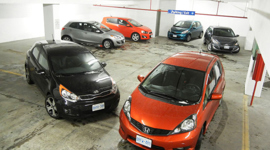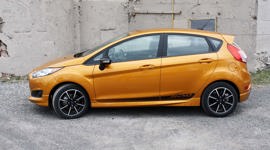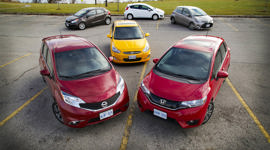 AutoTrader SCORE
AutoTrader SCORE
-
COMFORT6/10
-
PERFORMANCE8/10
-
FUEL ECONOMY8/10
-
INTERIOR8/10
-
EXTERIOR STYLING7/10
Not too long ago, if you bought a small car, you settled for a very basic vehicle. After all, if you were buying small, you were assumed to be, shall we say, cost-conscious. If you had more money, you’d buy a bigger, more luxurious car, right?
For buyers in this segment, cars like the Fiesta Titanium have it all, and less.
Not necessarily. Many people -- especially in Canada -- simply prefer a small car, and a significant number of them also want it to be well-equipped. In fact, some want it to be loaded. Voila! A whole new market segment!
For instance, at a starting price of $23,849 including freight/PDI, you can buy a diminutive, subcompact 2016 Ford Fiesta “Titanium” hatchback (a sedan is also available) with a six-speed automatic transmission, heated seats, 16-inch alloy wheels, the new SYNC3 touchscreen interface, Sony audio, satellite radio, leather upholstery, rear-view camera, push-button start, heatable mirrors with integrated blind spot mirror (although not a camera-based system), keyless push-button start, capless fuel filler and more.
Our tester added a $1,200 power moonroof and an $800 navigation system that increased the price to $26,049 plus taxes. Heck, you could buy a very nice mid-size car for that kind of money! But then you’d be in a different market segment: bigger, less maneuverable, less fuel-efficient, arguably less fun to drive.
No, for buyers in this segment, cars like the Fiesta Titanium have it all, and less.
Under the hood of this front-wheel drive, four-door hatch is the standard 1.6 L four-cylinder engine with twin-independent variable valve timing making 120 hp at 6,350 rpm and 112 lb-ft of torque at 5,000 rpm (not to be confused with the turbocharged “EcoBoost” version of this engine found in the Fiesta ST). The six-speed, twin-clutch “PowerShift” automatic transmission is a $1,250 upsell from the standard five-speed manual.
Fuel consumption is rated at a frugal 8.7/6.4/7.6 L/100km city/highway/combined. In combination with the low fuel consumption, a 46.9 L fuel tank (generous for a subcompact) gives you very good range. A bonus for those concerned about emissions is that this engine enables the Fiesta to be rated as a Partial Zero Emissions Vehicle (PZEV), which is as good as it gets regarding tailpipe and evaporative emissions from gasoline-powered cars.
Brakes are front disc, rear drums; suspension is front independent coil and rear twist beam with coil springs (kind of old school, actually, but the results have proven effective in smaller cars).
The Sriracha Option: 2015 Ford Fiesta ST
Our tester’s two-tone Medium Light Stone interior contrasted nicely with the striking Kona Blue exterior and may add to a feeling of spaciousness within (black upholstery is optional). Regardless, it’s surprising how much room is in a Fiesta, especially for front seat occupants, and how comfortable the seats are once the driver settles in behind the wheel. The front seat passenger likewise is treated to lots of leg and shoulder room (and headroom, too, despite the presence of the moonroof). Door panels and dashboard are all trimmed with soft-touch materials, headlights activate automatically and interior illumination of switches, door handles and power window controls make them easy to find and use, including the helpfully illuminated drink holders in the center console.
Rear-seat occupants have their own doors, so ingress and egress is not too much of a chore, but it’s not as airy back there. Ford classes the Fiesta as a five-passenger vehicle, and it’s true there are seatbelts for five, but I wouldn’t recommend five adults for longer drives in a car this size. Move the front seats up a bit and taller rear seat passengers will thank you, although there’s only one small drink holder for rear seat occupants and no pockets in the doors (there are storage compartments in the back of each front seat, though). Overall, the back seat area is tidy, tight and less lavishly appointed.
Behind the rear seat there’s useful cargo space. It’s not huge, but it’s sufficient for groceries or a couple of suitcases plus bags. But surprise, there’s a false floor. Lift it and you’ve got a large secure area for valuables; remove it and you’ll be able to transport taller items. Drop the 60/40 rear seats (they fold pretty much flat) and you really open up the cargo area for larger items.
I was cautiously optimistic about the new SYNC3 voice activation system. The last time I tried communicating with SYNC in a Lincoln MKC, well, the two of us didn’t quite get along. Ford promised improvements and I’m pleased to report that this version is much better. But I must warn you to take requests for input from SYNC3 literally. For instance, when it asks you to “Say address,” it doesn’t actually want the address. No, it wants you to say the word “address.” A quirk, I guess.
Anyway, then you give the address: street number, street, city and province (if the latter is required) all in one sentence. Happily, I had no trouble with the new system; no arguments, no verbal fisticuffs. We got along, in other words, which is great because effective voice activation really is the solution to distractions caused by touchscreens, joysticks and other forms of machine interface that take your eyes off the road.
On the road the Fiesta is responsive and agile. The engine’s 120 hp is more than sufficient to propel this little car with enthusiasm. Parking is simple in a car this size, as is reversing, and outward visibility is good in all directions. It’s a fun-to-drive, practical and well-equipped little vehicle that delivered a surprisingly good 7.2 L/100 km in exclusively city driving during my time behind the wheel (that’s lower than the combined city/highway rating of 7.4 L/100 km and I wasn’t trying to break any fuel economy records).
What I did notice, though, is a peculiar shudder when moving from standstill at a stoplight or in stop-and-go traffic. At first I thought it was the road surface or something, but no, it was definitely the Fiesta.
Turns out this is a characteristic of the automatic transmission’s transfer case. It shudders at low speed. Additionally, the transmission will appear to hesitate when downshifting, like when you put your foot on the clutch when driving a car with a manual transmission, and the car “freewheels” until you release the clutch and either accelerate or allow the vehicle to slow with engine braking.
This, apparently, is another peculiarity of this twin-clutch transmission which otherwise is just fine. But like the voice activation, it takes a little getting used to.
Something you may want to know is that the Fiesta’s ostensibly generous five-year powertrain warranty is compromised by a 57,000 km limit, which is certainly unusual. The overall warranty is three years, 57,000 km, in case you’re comparing manufacturer warranties.
Two equivalently equipped competitors are the Honda Fit EX-L Navi and the Kia Rio SX Navigation.
Overall, the 2016 Ford Fiesta is a pleasant ride that offers many current technologies and near-luxury amenities. Ford continues to work on SYNC and the latest version is an improvement that’s easy to use and less distracting.
| Warranty: 3 years/57,000 km; 5 years/57,000 km powertrain; 5 years/unlimited distance corrosion perforation; 5 years/57,000 km roadside assistance Competitors: |
| Model Tested | 2016 Ford Fiesta Titanium |
|---|---|
| Base Price | $20,899 |
| A/C Tax | $100 |
| Destination Fee | $1,600 |
| Price as Tested | $26,049 |
|
Optional Equipment
Automatic transmission - $1,250, Graphic package - $200, Moonroof - $1,200, Navigation - $600
|
|





























